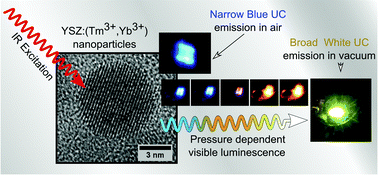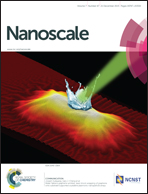Upconversion luminescence and blackbody radiation in tetragonal YSZ co-doped with Tm3+ and Yb3+
Abstract
Lanthanide doped inorganic nanoparticles with upconversion luminescence are of utmost importance for biomedical applications, solid state lighting and photovoltaics. In this work we studied the downshifted luminescence, upconversion luminescence (UCL) and blackbody radiation of tetragonal yttrium stabilized zirconia co-doped with Tm3+ and Yb3+ single crystals and nanoparticles produced by laser floating zone and laser ablation in liquids, respectively. The photoluminescence (PL) and PL excitation (PLE) were investigated at room temperature (RT). PL spectra exhibit the characteristic lines in UV, blue/green, red and NIR regions of the Tm3+ (4f12) under resonant excitation into the high energy 2S+1LJ multiplets. Under NIR excitation (980 nm), the samples placed in air display an intense NIR at ∼800 nm due to the 1G4 → 3H5/3H4 → 3H6 transitions. Additionally, red, blue/green and ultraviolet UCL is observed arising from higher excited 1G4 and 1D2 multiplets. The power excitation dependence of the UCL intensity indicated that 2–3 low energy absorbed photons are involved in the UCL for low power levels, while for high powers, the identified saturation is dependent on the material size with a enhanced effect on the NPs. The temperature dependence of the UCL was investigated for single crystals and targets used in the ablation. An overall increase of the integrated intensity was found to occur between 12 K and the RT. The thermally activated process is described by activation energies of 10 meV and 30 meV for single crystals and targets, respectively. For the NPs, the UCL was found to be strongly sensitive to pressure conditions. Under vacuum conditions, instead of the narrow lines of the Tm3+, a wide blackbody radiation was detected, responsible for the change in the emission colour from blue to orange. This phenomenon is totally reversible when the NPs are placed at ambient pressure. The UCL/blackbody radiation in the nanosized material exhibits non-contact pressure colour-based sensor characteristics. Moreover, tuning the color of the blackbody radiation in the nanoparticles by harvesting the low energy photons into the visible spectral region was found to be possible by adjusting the excitation power, paving the way for further developments of these nanoparticles for lighting and photovoltaic applications.


 Please wait while we load your content...
Please wait while we load your content...